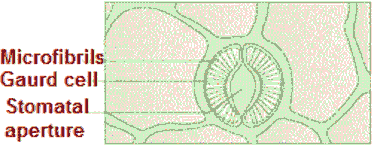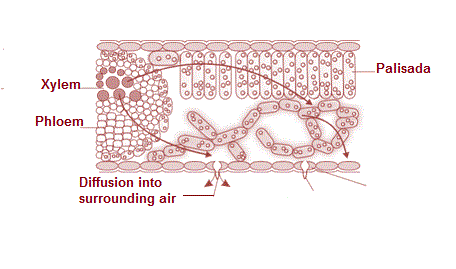Transpiration
Transpiration is the evaporative loss of water by plants. It occurs mainly through stomata. Apart of water-vapour loss in transpiration, the exchange of oxygen and carbon dioxide in the leaf also occurs through these stomata.
Normally stomata are open during day and close during the night. The immediate cause of the opening or closing of stomata is a change in the turgidity of the guard cells.
The inner wall of each guard cell, towards the pore or stomatal aperture is thick and elastic.
When turgidity increases within the two guard cells flanking each stomatal aperture or pore, the thin outer walls bulge out and force the inner walls into a crescent shape.
The opening of the stoma is also aided due to the orientation of the microfibrils in the cell walls of the guard cells.

Cellulose microfibrils are oriented radially rather than longitudinally making it easier for the stoma to open. When the guard cells lose turgor, due to water loss (or water stress) the elastic inner walls regain their original shape, the guard cells become flaccid and the stoma gets close.
Usually the lower surface of a dorsiventral (often dicotyledonous) leaf has a greater number of stomata while in an isobilateral (often monocotyledonous) leaf they are about equal on both surfaces.
Transpiration is affected by several external factors: temperature, light, humidity and wind speed. Plant factors that affect transpiration include number and distribution of stomata, per cent of open stomata, water status of the plant, canopy structure etc.
The transpiration driven ascent of xylem sap depends mainly on the following physical properties of water:
- Cohesion – mutual attraction between water molecules.
- Adhesion – attraction of water molecules to polar surfaces.
- Surface Tension – water molecules are attracted to each other in the liquid phase more than to water in the gas phase.
These properties give water high tensile strength (ability to resist a pulling force) and high capillarity (ability to rise in thin tubes). In plants capillarity is aided by the small diameter of the tracheary elements (tracheids and vessel elements).
The process of photosynthesis requires water. The system of xylem vessels from the root to the leaf vein can supply the needed water.
What force does a plant use to move water molecules into the leaf parenchyma cells where they are needed?
As water evaporates through the stomata, since the thin film of water over the cells is continuous, it results in pulling of water, molecule by molecule, into the leaf from the xylem.

Also, because of lower concentration of water vapour in the atmosphere as compared to the substomatal cavity and intercellular spaces, water diffuses into the surrounding air. This creates a ‘pull’.
Measurements reveal that the forces generated by transpiration can create pressures sufficient to lift a xylem sized column of water over 130 metres high.
Transpiration and photosynthesis
Its a compromise transpiration has many purpose as follows:
- It creates transpiration pull for absorption and transport of plants.
- It supplies water for photosynthesis.
- It transports minerals from the soil to all parts of the plant.
- It cools leaf surfaces, sometimes 10 to 15 degrees, by evaporative cooling.
- It maintains the shape and structure of the plants by keeping cells turgid.
An actively photosynthesising plant has an insatiable need for water. Photosynthesis is limited by available water which can be swiftly depleted by transpiration.
The humidity of rainforests is largely due to this vast cycling of water from root to leaf to atmosphere and back to the soil.
The evolution of the C4 photosynthetic system is probably one of the strategies for maximising the availability of CO2 while minimising water loss.
C4 plants are twice as efficient as C3 plants in terms of fixing carbon dioxide (making sugar).
However, a C4 plant loses only half as much water as a C3 plant for the same amount of CO2 fixed.
1. Stomatal Transpiration
2. Cuticular Transpiration
3. Lenticular or Lenticellate Transpiration
4. Bark Transpiration
Difference between transpiration and evaporation
| Transpiration | Evaporation |
|---|---|
| It is a biological process. | It is a physical process. |
| It is a slow process. | It is comparatively a fast process. |
| It occurs in living tissues. | It involves non-living matter. |
| In the process of transpiration water is lost from plant cells | In this process, water is lost from the surface of plant parts |
| It occurs through stomata, cuticle or lenticel. | It occurs from the entire outer surface |
| It occurs during the daytime. | It occurs during day as well as night |
| It is regulated by temperature, light, concentration, pH, hormones and carbon dioxide. | There is no such regulations or control over the Evaporation. |
| Surface remains wet | Surface becomes dry |
| It helps in the uptake of minerals and nutrients. | It is not associated with uptake of minerals or nutrients |
| The osmotic potential and water potential controlled the transpiration.. | It is independent of these processes |
| It makes the surface of leaves and young stems wet and protects them from sunburn. | It provides dryness to the free surface. |
